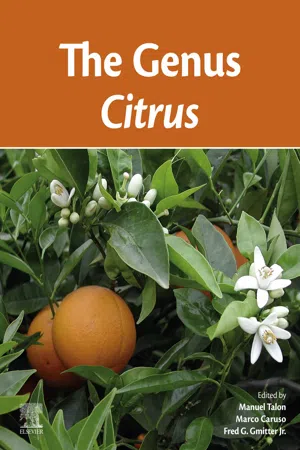
- 538 pages
- English
- ePUB (mobile friendly)
- Available on iOS & Android
The Genus Citrus
About this book
The Genus Citrus presents the enormous amount of new knowledge that has been generated in recent years on nearly all topics related to citrus. Beginning with an overview of the fundamental principles and understanding of citrus biology and behavior, the book provides a comprehensive view from Citrus evolution to current market importance. Reporting on new insights supported by the elucidation of the citrus genome sequence, it presents groundbreaking theories and fills in previous knowledge gaps.Because citrus is among the most difficult plants to improve through traditional breeding, citrus researchers, institutions and industries must quickly learn to adapt to new developments, knowledge and technologies to address the biological constraints of a unique fruit-tree such as citrus. Despite the challenges of working with citrus, tremendous progress has been made, mostly through advances in molecular biology and genomics. This book is valuable for all those involved with researching and advancing, producing, processing, and delivering citrus products.- Includes the most current research on citrus genomic information- Provides the first detailed description of citrus origin, a new proposal for citrus taxonomy, and a redefinition of the genus Citrus- Details citrus challenges including climate change, global disease impacts, and plant improvement strategies
Frequently asked questions
- Essential is ideal for learners and professionals who enjoy exploring a wide range of subjects. Access the Essential Library with 800,000+ trusted titles and best-sellers across business, personal growth, and the humanities. Includes unlimited reading time and Standard Read Aloud voice.
- Complete: Perfect for advanced learners and researchers needing full, unrestricted access. Unlock 1.4M+ books across hundreds of subjects, including academic and specialized titles. The Complete Plan also includes advanced features like Premium Read Aloud and Research Assistant.
Please note we cannot support devices running on iOS 13 and Android 7 or earlier. Learn more about using the app.
Information
The citrus genome
b US Department of Energy Joint Genome Institute, Walnut Creek, CA, United States
c Department of Molecular and Cell Biology and Center for Integrative Genomics, University of California, Berkeley, Berkeley, CA, United States
d Molecular Genetics Unit, Okinawa Institute of Science and Technology Graduate University, Onna, Japan
e Centro de Genómica, Instituto Valenciano de Investigaciones Agrarias (IVIA), Valencia, Spain
Abstract
Keywords
1.1 Concept of genome
1.2 Citrus genomes
Table of contents
- Cover image
- Title page
- Table of Contents
- Copyright
- Contributors
- Chapter 1: The citrus genome
- Chapter 2: The origin of citrus
- Chapter 3: Domestication and history
- Chapter 4: Citrus taxonomy
- Chapter 5: Commercial scion varieties
- Chapter 6: Citrus rootstocks
- Chapter 7: Traditional breeding
- Chapter 8: Genomic breeding
- Chapter 9: Citrus biotechnology
- Chapter 10: Vegetative growth
- Chapter 11: Flowering and fruit set
- Chapter 12: Fruit growth and development
- Chapter 13: Citrus in changing environments
- Chapter 14: Salinity and water deficit
- Chapter 15: Soil and nutrition interactions
- Chapter 16: Citrus pests in a global world
- Chapter 17: Diseases caused by fungi and oomycetes
- Chapter 18: Bacterial pathogens of citrus: Citrus canker, citrus variegated chlorosis and Huanglongbing
- Chapter 19: Citrus viruses and viroids
- Chapter 20: Horticultural practices
- Chapter 21: Postharvest technology of citrus fruits
- Chapter 22: Chemistry of citrus flavor
- Chapter 23: Global economics and marketing of citrus products
- Chapter 24: Citrus and health
- Index